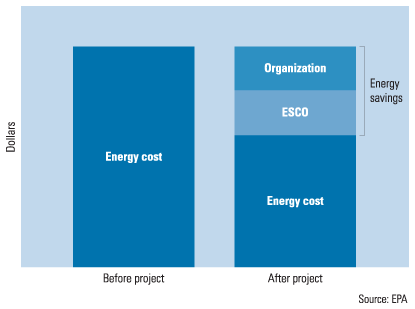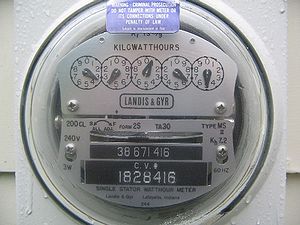A Performance Contract with an Energy Services Company (ESCO) can be a powerful tool to enable a business to improve the performance of their facility without requiring money upfront. An ESCO assesses a facility’s energy efficiency opportunity, manages the improvement implementation and guarantees the energy savings will be greater than the cost of the project. In my recent blog post, ESCO: Energy Efficiency Investment with No Money Down, I describe the process of a Performance Contract and state “the ESCO assumes the risk of under-performance.” In recent months, however, the cost of natural gas has decreased substantially and many existing Performance Contracts are seeing negative savings for which the building owners are responsible.
Financial Basis for a Performance Contract
The financial portion of a Performance Contract is written so that the project costs are paid for by the project energy savings. The ESCO determines energy savings based on their calculation of the projected “baseline” energy costs – the building’s cost without the energy improvements – as determined by analyzing the building’s historical energy usage. The contract is typically structured so that the owner continues to pay the projected baseline energy costs over the life of the project. Project savings are the difference between the baseline projected costs and the actual post-construction utility costs.
Make or Break: Financial Adjustments to Performance Contracts
When all goes well, the building owner budgets for the same utility costs as if the project hadn’t happened and the project does not produce an increase in monthly overhead costs. In order to create projects that generate enough savings to cover the project investments as well as the ESCO profit and risk mitigation, there are a number of variables the ESCO can adjust when writing the contract:
1) The scope of the measures to be implemented. Long term measures such as building envelope improvements (insulation or windows) or high-cost measures such as HVAC system replacements can be excluded from the contract if the cost is more than the savings can bear within the contract period. The drawback to this is that measures with long-term paybacks typically will never happen when not coupled with measures that have quick return on investments. Other aspects of the buildings, such as comfort, maintenance costs and equipment life, usually suffer when only quick payback measures, such as lighting replacements, are implemented.
2) The contract term. The contract period can be adjusted to cover the cost of the package of energy improvement measures. For example, if insulating the building increases the payback period of the project from 8 years to 12 years, the contract can be written for 15 years instead of 10 years. The thing to watch out for is if the contract period extends past the life of the equipment. If the contract is written for 20 years, but the measures themselves need to be replaced after 10 years, then an owner should look carefully at the financial benefits of this long-term contract.
3) The escalation rate of utility costs. Determining escalation rates for energy is a challenging process. No one can predict the future and the longer a contract extends, the less certainty there is around energy rates. The Energy Information Administration is a good source of information that often serves as a starting point for determining contracted escalation rates. The ESCO can adjust the contract escalation rates in order to generate the cash flow needed to make a contract cash-positive. This stipulation leaves the owner vulnerable to future price fluctuations.
A Red Herring: Escalation Rates
According to a NIST study conducted in September 2011 on behalf of DOE, the Northeast commercial costs for both electricity and natural gas will decrease approximately 6% over the next 8 years and then will increase 10% over the following 8 years for a total net increase of approximately 3% from 2012 to 2026. If a 10 year Performance Contract was written two years ago with an annual gas escalation rate of 2.5%, the owner will pay higher costs than they would have without the contract. This could result in the owner seeing a net negative cash-flow for the term of the Performance Contract; however, at the end of the contract they will begin to accrue savings. When the project construction, as well as ESCO costs, has been paid off, the owner will begin paying the actual energy costs and will realize the full energy savings.
Beware of the Performance Contract Fine Print
An owner or their representative should be very aware of the fine print in the Performance Contract. An owner would be well served to investigate utility cost projections for their region and ask questions on the merits of the package of energy efficient measures, the contract period and the proposed escalation rates. Less experienced project owners may be well served by hiring an independent consultant with expertise in performance contracting and energy efficiency to be their representative in the performance contracting process. An independent consultant can identify and help the owner fully understand all of the risks associated with the project.
Most ESCOs are reputable, but keep in mind that Performance Contracts are written to minimize the risk to the ESCO, which often results in risks being shifted to you as the building owner.




